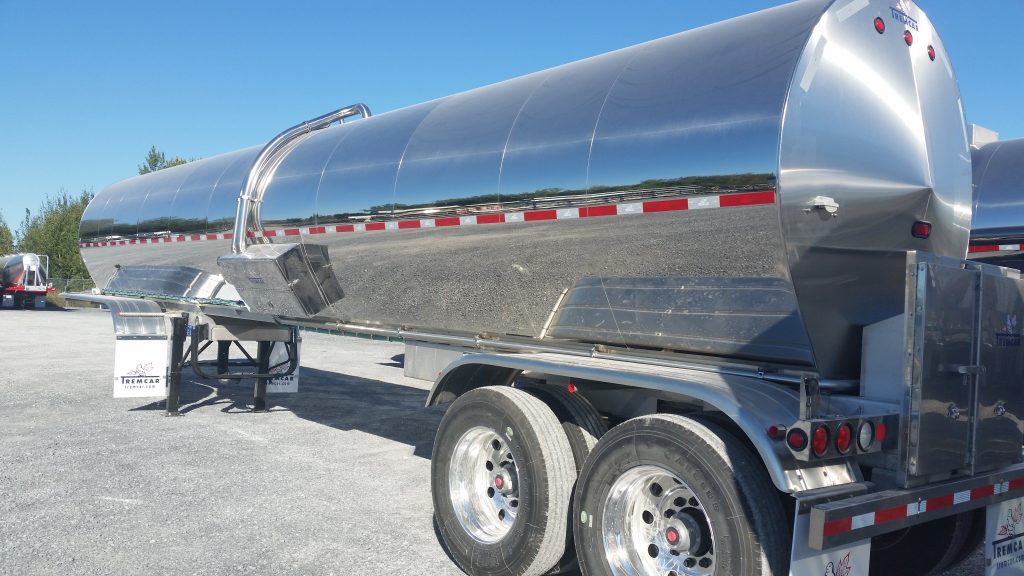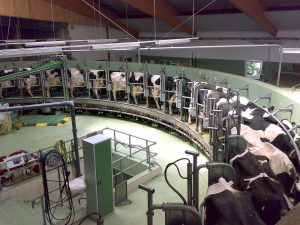Milk hauling offers many great benefits above and beyond the regular perks of driving a truck for a living. Unlike many other transport jobs, dairy hauling involves a regular route where drivers can get to know the farmers they meet, and can form a routine, which means that drivers get to sleep in their own beds each night.
To earn those perks, drivers work extremely hard not only to make sure that every day’s milk gets to the processing plant promptly, but also to ensure that they meet the highest standards for food safety in everything they do. That’s because unlike other drivers, milk haulers are also responsible for much of the milk tank cleaning and sanitizing that’s necessary to ensure healthy milk for consumers.
Milk Pick-Up
At each farm, the driver is responsible for inspecting and sampling the milk to ensure that it is free from visible contamination or issues before loading it onto the truck’s tank. If it passes the initial inspection, the driver may carefully load the milk into their truck’s tank.
Cleaning Up
Once loading is complete, the drivers are responsible for cleaning the farm’s bulk tank and all the equipment so that everything is ready for the next round of milking. To do so, they follow carefully-outlined procedures that involve:
- Inspecting: Before rinsing the bulk tank, the driver should inspect it to ensure that no milk foam, sediment, precipitated milk solids or churned fat remain at the bottom of the tank or on the sides. (If found, these should be reported to the producer and the receiving plant, in case they are symptomatic of an issue that requires attention.)
- Rinsing: The driver must rinse all equipment with lukewarm water (100-110 degrees Fahrenheit) immediately after emptying the farm truck to prevent any leftover milk from drying on surfaces. This includes the bulk tank, bridge and lid or cover, which he or she can rinse once loading is complete (and after disconnecting the hose). Doing so will make it much easier for the farmer to wash the tank. The driver should also note any evidence that the tank was not properly cleaned after the last washing, and report this to the producer and their supervisor.
!Note: Water should be lukewarm and not hot to prevent it from denaturing proteins, which can cause a film to build on surfaces. It should not exceed 120 degrees Fahrenheit. Likewise, if the water is too cold it can cause milk fats to crystallize, leaving a greasy film.
- Auto Washing: Next, the driver may be required to wash the equipment with hot water (beginning with water around 170 degrees and now allowing it to cool to below 120 degrees). The precise method for cleaning and rinsing varies depending on the type of bulk tank used (cleaning may be automatic or manual), but should last between six to eight minutes, include a detergent or cleaning solution, and involve some method of auto-scouring or auto-scrubbing the equipment. In all cases, the driver should inspect the tank after completing the washing cycle to ensure that everything has been properly and adequately cleaned.
- Auto Rinsing (Again): Once washed, everything should be rinsed thoroughly to remove all traces of detergent or cleaning solution. Once the interior of the bulk tank and all equipment are clean, the driver should rinse the outside of the bulk tank and the milk house floor.
- Auto Acid Rinsing: Using lukewarm or cold acidified water, the bulk tank should be rinsed thoroughly. The acid rinse should circulate for two to three minutes, then be drained.
- Final Steps: The driver can now replace the rinse hose on its rack, turn off all lights, and close the milk house door on his or her way out.

Tremcar, Milk Tanker
Enjoying our insights?
Subscribe to our newsletter to keep up with the latest industry trends and developments.
Stay InformedDon’t Forget The Truck’s Tank!
Once all milk transport is done for the day, drivers must also clean and sanitize their milk truck’s tank to ensure it’s ready for the next pickup. Cleaning procedures are roughly the same as above, but with these important extra steps:
- Dismantling: As with the bulk tank at the farm, some components of the truck’s tank may need to be dismantled for proper cleaning. For the truck, these include: the milk pump and its parts, the tanker hose and its parts,, the manhole cover and its parts, and the stainless steel inlet to the tank and its gaskets.
- Wash Tag: Once cleaning is complete, the tank should be tagged with the name or initials of the person who cleaned it, the date and the name and location of the dairy plant. This tag must remain on the tank’s sampling compartment until the next washing (at which point it should be replaced with the new tag). All tags must be kept as records for a minimum of 15 days.
- Sanitizing: Ideally, tanks should only be sanitized right before use to prevent corrosion of the stainless steel components. When this is not possible, however, it may be done in advance, but should be done with noncorrosive sanitizers. In such cases, sanitization should occur immediately after cleaning.
Raise a Cold Glass of Milk to Those Behind the Scenes
When it comes to long lists of equipment and protocol, milk haulers probably corner the market. All those steps are in place to ensure that the milk that makes it to grocery store shelves is as safe and healthy as possible. So next time you raise a cold glass of milk, or dunk a cookie into a tumbler full of 2 percent, whisper a word of thanks to the drivers behind the scenes who work hard to deliver dairy products.
(this article was originally posted in Legislation and Regulation)





















